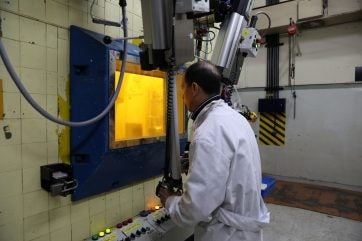
Argentina’s National Atomic Energy Commission (CNEA – Comisión Nacional de Energía Atómica) has begun a three-stage process to increase radioisotope production with the aim of obtaining a surplus for export. The first phase of this process is underway and will result in an increase of 31%.
Radioisotopes are produced in the RA-3 research reactor, at the Ezeiza Atomic Centre. CNEA produces enough radioisotopes to satisfy domestic demand. It has now reorganised the work of the reactor and associated production plants to generate a surplus for export. By December, the goal is to have 50% more molybdenum-99 and 22% more iodine-131 every week.
“For 25 years, we have supplied the national market for molybdenum and iodine and sold all output. Now, with great efforts from all the personnel involved, “we reorganised to add an extra shift at the RA-3 and modified the day for the radiochemical process. In this way, with existing resources and without the need to invest new funds, we managed to significantly increase the production of molybdenum and iodine to be able to export them,” explained Ariel Novello, manager of CNEA’s Radioisotope Production & Radiation Applications Area.
To achieve the new production goals, staff shifts and tasks had to be changed. In this way, the RA-3 reactor added eight hours of irradiation each week, increasing continuous operation from 66 to 74 hours. In the second stage it will operate for 82 hours and in the third, 90 hours. In this way, by the end of November it will be operating for an additional day.
The day that the reactor ends its operation run, the irradiated uranium plates are sent to the Radioisotope Fission Production Plant (PPRF – Planta de Producción de Radioisótopos por Fisión), where the products of interest are purified for 15 continuous hours using a radiochemical process. The radioisotopes obtained then go to the Radioisotope Production Plant (PPR – Planta de Producción de Radioisótopos) for final conditioning, quality controls, fractionation and dispatch for sale,” said Engineer Ariel Bellino, in charge of RA-3 Research and Production Reactor Management.
The adjustment in logistics, added to the extension of the time in which the irradiation is carried out in the reactor, enables the radioisotopes to be delivered in good condition.The export of molybdenum and iodine will generate foreign exchange and will position Argentina in the market ready for the launch of the RA-10 reactor, which will have the capacity to supply 20% of world demand for radioisotopes.
The 30 MWt RA-10, currently under construction will replace the 10 MWt RA-3 which began operation in 1967. The RA-10 is based on the OPAL radioisotope production reactor that INVAP supplied to Australia in 2007. It is planned to be commissioned in 2026 for full operation in 2027. As well as producing radioisotopes for export it will develop new radioisotopes and produce high quality doped silicon for high power electronics applications. It will also be used for fuel and materials testing.






